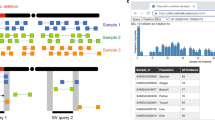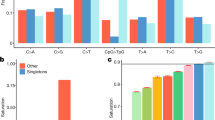Abstract
Single-nucleotide polymorphisms (SNPs) are the most abundant form of human genetic variation and a resource for mapping complex genetic traits1. The large volume of data produced by high-throughput sequencing projects is a rich and largely untapped source of SNPs (refs 2, 3, 4, 5). We present here a unified approach to the discovery of variations in genetic sequence data of arbitrary DNA sources. We propose to use the rapidly emerging genomic sequence6,7 as a template on which to layer often unmapped, fragmentary sequence data8,9,10,11 and to use base quality values12 to discern true allelic variations from sequencing errors. By taking advantage of the genomic sequence we are able to use simpler yet more accurate methods for sequence organization: fragment clustering, paralogue identification and multiple alignment. We analyse these sequences with a novel, Bayesian inference engine, POLYBAYES, to calculate the probability that a given site is polymorphic. Rigorous treatment of base quality permits completely automated evaluation of the full length of all sequences, without limitations on alignment depth. We demonstrate this approach by accurate SNP predictions in human ESTs aligned to finished and working-draft quality genomic sequences, a data set representative of the typical challenges of sequence-based SNP discovery.
This is a preview of subscription content, access via your institution
Access options
Subscribe to this journal
Receive 12 print issues and online access
$209.00 per year
only $17.42 per issue
Buy this article
- Purchase on Springer Link
- Instant access to full article PDF
Prices may be subject to local taxes which are calculated during checkout





Similar content being viewed by others
References
Collins, F.S., Guyer, M.S. & Chakravarti, A. Variations on a theme: cataloging human DNA sequence variation. Science 278, 1580– 1581 (1997).
Wang, D.G. et al. Large-scale identification, mapping, and genotyping of single nucleotide polymorphisms in the human genome. Science 280,1077–1082 (1998).
Taillon-Miller, P., Gu, Z., Hillier, L. & Kwok, P.-Y. Overlapping genomic sequences: a treasure trove of single-nucleotide polymorphisms. Genome Res. 8, 748–754 ( 1998).
Picoult-Newberg, L. et al. Mining SNPs from EST databases. Genome Res. 9, 167–174 (1999).
Buetow, K.H., Edmondson, M.N. & Cassidy, A.B. Reliable identification of large numbers of candidate SNPs from public EST data. Nature Genet. 21, 323–325 (1999).
The Sanger Centre & The Washington University Genome Sequencing Center. Toward a complete human genome sequence. Genome Res. 8, 1097–1108 (1998).
Venter, J.C. et al. Shotgun sequencing of the human genome. Science 280, 1540–1542 ( 1998).
Hillier, L. et al. Generation and analysis of 280,000 human expressed sequence tags. Genome Res. 6, 807– 828 (1996).
Adams, M.D., Soares, M.B., Kerlavage, A.R., Fields, C. & Venter, J.C. Rapid cDNA sequencing (expressed sequence tags) from a directionally cloned human infant brain cDNA library. Nature Genet. 4, 373–380 (1993).
Hudson, T.J. et al. An STS-based map of the human genome. Science 270, 1945–1954 (1995).
Marra, M., Weinstock, L.A. & Mardis, E.R. End sequence determination from large insert clones using energy transfer fluorescent primers. Genome Res. 6, 1118–1122 (1996).
Durbin, R. & Dear, S. Base qualities help sequencing software. Genome Res. 8, 161–162 (1998).
Ewing, B., Hillier, L., Wendl, M.C. & Green, P. Base-calling of automated traces using Phred. I. Accuracy assessment. Genome Res. 8, 175–185 (1998).
Ewing, B. & Green, P. Base-calling of automated traces using Phred. II. Error probabilities. Genome Res. 8, 186–194 (1998).
Bayes, T. An essay towards solving a problem in the doctrine of chances. Philos. Trans. R. Soc. 53, 370–418 (1763). Reprinted in Biometrika 45, 293–315 (1958).
Aaronson, J. et al. Toward the development of a gene index to the human genome: an assessment of the nature of high-throughput EST sequence data. Genome Res. 6, 829–845 (1996).
Kwok, P.-Y., Carlson, C., Yager, T., Ankener, W. & Nickerson, D.A. Comparative analysis of human DNA variations by fluorescence-based sequencing of PCR products. Genomics 23, 138–144 (1994).
Taillon-Miller, P. et al. The homozygous complete hydatidiform mole: a unique resource for genome studies. Genomics 46, 307– 310 (1997).
Collins, F.S. et al. New goals for the U.S. Human Genome Project: 1998–2003. Science 282, 682–689 (1998).
Nickerson, D.A. et al. DNA sequence diversity in a 9.7-kb region of the human lipoprotein lipase gene. Nature Genet. 19, 233– 240 (1998).
Cargill, M. et al. Characterization of single-nucleotide polymorphisms in coding regions of human genes. Nature Genet. 22, 231–238 (1999).
Halushka, M.K. et al. Patterns of single-nucleotide polymorphisms in candidate genes regulating blood-pressure homeostasis. Nature Genet. 22, 239–247 (1999).
Gordon, D., Abaijan, C. & Green, P. Consed: a graphical tool for sequence finishing. Genome Res. 8, 195–202 (1998).
Acknowledgements
We thank T. Blackwell and S. Eddy for informative discussions during the development of the mathematical framework of the technique. This work was supported by NIH grants P50HG01458 (L.H. and W.R.G.), R01HG1720 (P.-Y.K.) and T32AR07284 (Z.G.), and an equipment loan from Compaq Computer Corporation.
Author information
Authors and Affiliations
Corresponding authors
Rights and permissions
About this article
Cite this article
Marth, G., Korf, I., Yandell, M. et al. A general approach to single-nucleotide polymorphism discovery. Nat Genet 23, 452–456 (1999). https://doi.org/10.1038/70570
Received:
Accepted:
Issue Date:
DOI: https://doi.org/10.1038/70570
This article is cited by
-
Preimplantation genetic testing for Aicardi–Goutières syndrome induced by novel compound heterozygous mutations of TREX1: an unaffected live birth
Molecular Cytogenetics (2023)
-
Automatic extraction of ranked SNP-phenotype associations from text using a BERT-LSTM-based method
BMC Bioinformatics (2023)
-
Identification of high-risk human papillomavirus isolates circulating in Nigeria and phylogenetic analysis based on the virus essential protein
Indian Journal of Gynecologic Oncology (2021)
-
Accuracy and reproducibility of somatic point mutation calling in clinical-type targeted sequencing data
BMC Medical Genomics (2020)
-
Genomic profiling of bacterial and fungal communities and their predictive functionality during pulque fermentation by whole-genome shotgun sequencing
Scientific Reports (2020)



